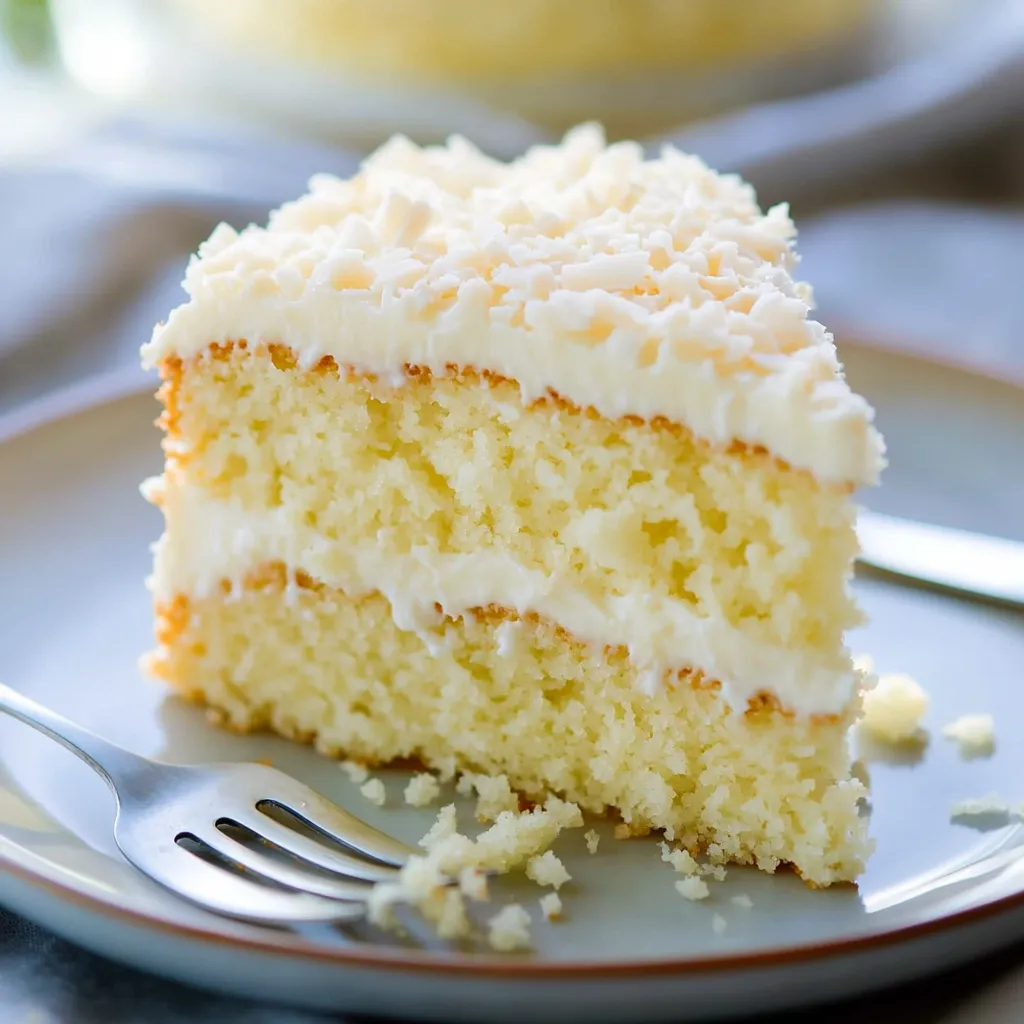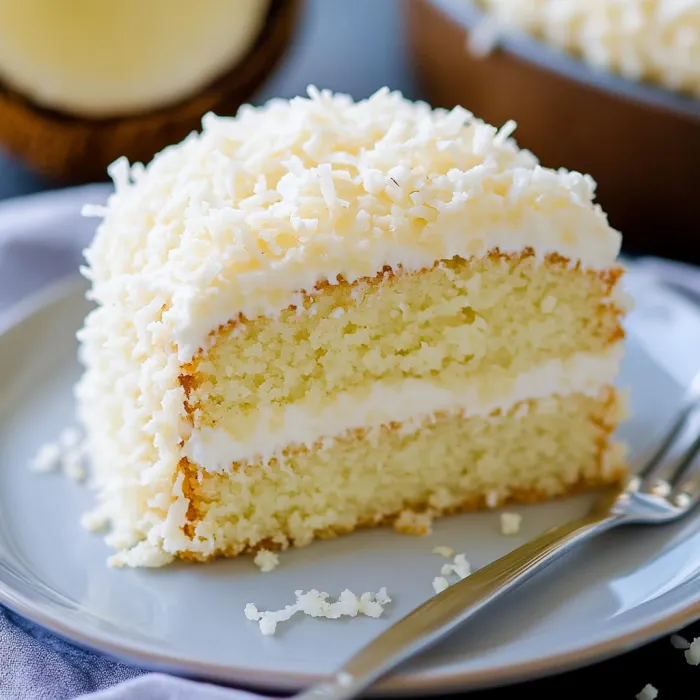 Save
Save
This Coconut Cake recipe is my go-to for birthdays and holidays when someone wants a treat that feels festive and comforting. The layers are supremely moist with coconut flavor in every bite and a snowy coconut finish that always impresses guests.
The first time I served this at a family Easter, everyone marveled that it tasted just like the coconut cakes from fancy bakeries yet felt homemade and cozy. Now it is my most-requested cake for special occasions.
Ingredients
- All-purpose flour: creates structure and keeps the cake delicate. Search for unbleached flour for the cleanest flavor
- Baking powder: gives rise and airiness. Check that your baking powder is fresh for best results
- Salt: lifts the sweetness and balances flavors. I prefer sea salt for subtle taste
- Unsalted butter: ensures rich flavor and perfect texture. Always use room temperature for easier mixing
- Granulated sugar: brings essential sweetness. Choose organic cane sugar for pure taste
- Eggs: bind the batter and add richness. Look for bright yolks for a golden crumb
- Vanilla extract: enhances the cake’s aroma. Use pure extract for best flavor
- Coconut extract: adds bold tropical notes. A high quality extract gives amazing flavor depth
- Coconut milk: ensures moistness and real coconut flavor. Use unsweetened canned coconut milk for creaminess
- Sour cream or Greek yogurt: brings tang and tender texture. Both options work but full fat is best
- Sweetened shredded coconut: adds texture and extra coconut taste. Choose fresh and soft shreds for the lightest finish
- Powdered sugar (for frosting): creates smoothness. Sift before using to avoid lumps
Step-by-Step Instructions
- Prepare the Cake:
- Set your oven to 350°F and get two 9 inch cake pans ready with a light layer of grease and dusting of flour or parchment. This helps your cakes release easily and prevents sticking.
- Mix Dry Ingredients:
- Whisk together the flour baking powder and salt in a medium bowl. Whisking evenly distributes the leavening and salt which ensures a uniform crumb.
- Cream Butter and Sugar:
- Beat the softened butter and sugar together in a large mixing bowl for about three to four minutes until it looks pale and fluffy. This step incorporates air which helps make the cake light. Add the eggs one at a time and beat until fully blended. Pour in the vanilla and coconut extracts and mix again.
- Combine and Fold:
- Pour in the coconut milk and sour cream and gently mix to combine. Gradually add the dry mixture beating slowly or by hand until just incorporated. Over mixing can make the cake tough. Gently fold in the shredded coconut with a spatula so the texture stays even.
- Bake:
- Spoon the batter evenly into your prepared cake pans. Place in the center of your oven and bake for about thirty to thirty five minutes. Check with a toothpick entered in the center and it should come out clean. Let cakes rest in pans for about ten minutes then carefully invert onto wire racks to cool fully.
- Make the Frosting:
- With a clean bowl and mixer beat the softened butter until smooth and creamy. Add powdered sugar cup by cup mixing until it becomes light and fluffy. Add coconut milk coconut extract and a pinch of salt. Beat until the frosting is silky.
- Assemble:
- Place one cake layer on your plate and spread a generous portion of frosting over the top. Set the second cake layer gently on top and frost the top and sides smoothly. Take handfuls of shredded coconut and press gently all over the cake for a classic coconut coating.
 Save
Save
My favorite part of this recipe is the fresh coconut scent that fills the kitchen while baking. Every time I make it my family gathers around the counter eager for a slice and we always argue over who gets the biggest piece from the center.
Storage tips
Wrap leftover cake slices tightly in plastic wrap or store in an airtight container at room temperature for up to two days. For longer storage keep the cake refrigerated and let it sit out for fifteen to twenty minutes before serving to bring back the soft texture. Coconut cake also freezes beautifully for up to three months if you wrap it well.
Ingredient substitutions
You can use plain full fat Greek yogurt instead of sour cream for a slightly tangier flavor. If unsweetened canned coconut milk is not available boxed coconut milk or even whole milk will work in a pinch but the flavor will be less pronounced. For a dairy free version swap the butter for vegan baking sticks and use plant based yogurt.
Serving suggestions
Decorate the top with toasted coconut flakes or fresh berries for a pop of color. Serve with a scoop of vanilla ice cream or a dollop of softly whipped cream to turn each slice into a true dessert experience. For a festive touch garnish with edible flowers.
Cultural and historical context
Coconut cake has its roots in Southern American baking where coconut was once considered a luxury ingredient. Over time it became an iconic celebration cake featured at weddings and holidays. The snowy coconut coating was seen as a symbol of prosperity and abundance.
Recipe FAQs
- → How do I keep the cake moist?
Mix sour cream or Greek yogurt into the batter and avoid overbaking for maximum moisture.
- → Can I use carton coconut milk?
Yes, either canned or carton coconut milk works, but canned adds richer flavor and texture.
- → How do I prevent sticking to the pans?
Grease and flour the pans or line them with parchment to help the cake layers release easily.
- → Is this dessert freezer-friendly?
Yes, the cake layers freeze well. Wrap tightly and thaw before frosting and serving.
- → Can I make it ahead of time?
This treat can be baked and assembled a day in advance. Refrigerate and bring to room temperature before serving.
- → What can I use as a garnish?
Finish with sweetened shredded coconut or try toasted coconut for added crunch and flavor.
